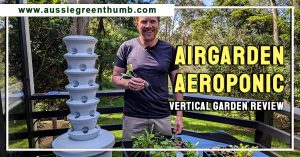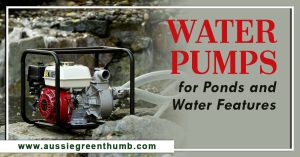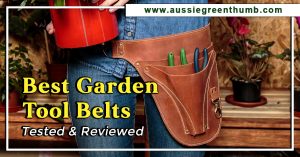If you’re thinking about starting a hydroponic garden at home, I’ll be the first to admit that it’s a complete maze of complicated information. From deep water hydroponics to micro-growing, there are so many different ways to grow hydroponics at home.
So, I’m going to try to demystify this wide new world of gardening, which is perfect for indoor growers, and keen grow-your-owners, but usually hidden behind a mist of expensive kit. We’ve got a guide to the kit you’ll need to start a hydroponic garden, as well as details on how to use it, and which setup is best for beginners.
More...
What is Hydroponics?
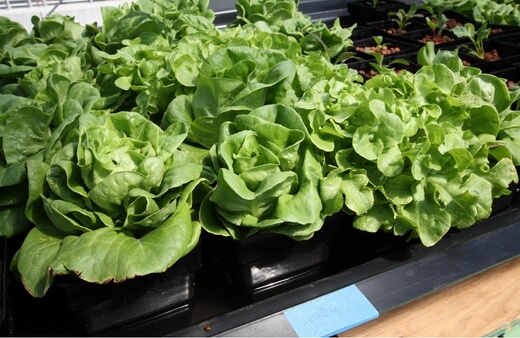
Hydroponics is the art of growing plants in water. It really is that simple. In practice, there’s a little more to it, but provided you can keep your water clean, oxygenated, and packed with nutrients to mimic the soil, your plants will grow with far less risk of disease, and produce better harvests.
My first foray into hydroponics was a complete failure, because, frankly, I started too big too soon. As a rule, when learning anything new in gardening, you should strip it right back to basics.
So, that’s what I did next, with a brilliant deep-water hydroponic kit that needs nothing more than proper water circulation, and regular changing. When you get started, stick to that. Forget about grow tents and fans, or indoor lighting, just keep things simple with a hydroponic window box.
How Do Plants Grow in Hydroponics?
While most plants grow best in soil, tons of plants thrive in water. Few will grow happily in standing water like lakes or bogs, but even those conditions can provide the conditions for plants to thrive, provided they have a good mix of oxygenators and pond life to fertilise the pool.
But, did you know, even ground-dwelling plants that naturally grow in the soil can root and grow happily in nothing but water? If you’ve ever taken mint cuttings, you’ll know exactly how it works.
Plants develop shorter, finer roots in soil because they need to access nutrients efficiently. In water, their roots swell and promote more vigorous growth. In plain water, plant roots never suffer from over-watering. This is because their roots adapt to their conditions.
So rather than soil-based roots (which rot in stagnant water), their water roots grow with these unique conditions in mind. In fact, some plants, like Monstera, will actually develop roots that are unique to submersion.
Advantages of Hydroponics
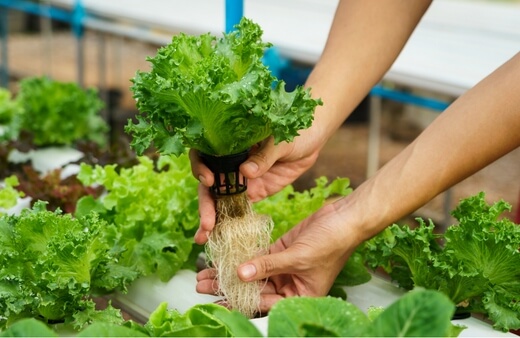
Hydroponics isn’t perfect for every plant. Root vegetables, for example, split, and grow too fast, developing fibrous roots which take precedence over the crop part of the root. Tomatoes, hemp, and lettuces though, grow exceptionally well in water. As do most soft herbs like basil and coriander.
These plants need regular moisture to grow evenly, without strain on the top growth. In soil, we do this by soaking the roots once every couple of days. In water, that moisture is constantly available.
Faster Growing
This consistent access to water means faster, more predictable, and more even growth. The results are fresher-tasting foliage, and (with the right lighting) more flowers, earlier in the year.
Control of harvest time
By providing more water, plants develop more reliably and don’t run the risk of transplant shock. For indoor setups, that also means the risk of frost is entirely avoided, so not only do they not suffer from transplant shock, they don’t need any hardening off period either.
Great for indoor growers
For anyone with limited outdoor space, hydroponics make growing indoors completely possible, without the mess of soil-filled pots on every windowsill.


Get Your Free Guide:
Master Growing Australian Natives eBook
A Must Have Complete Guide for Every Australian Garden
Get Your Free Guide:
Master Growing Australian Natives eBook
A Must Have Complete Guide for Every Australian Garden
Space saving
Growing hydroponically might seem like a big space commitment, but in comparison to growing leaf vegetables in the soil, you can grow much more in a smaller space with hydroponics.
Obviously growing plants too tightly can cause ventilation problems, but tiered hydroponic systems and ventilated rooms can reduce this risk.
Disadvantages of Hydroponics
There are some practical negatives to growing hydroponically, which are mostly related to costs, but a simple DIY hydroponic system can cost nothing to run, provided you can provide regular water changes.
Running costs
Hydroponics often require running water, indoor lighting, and ventilation, which can ramp up your gardening costs in the form of energy bills. However, these costs can be negated by static water hydroponics, and with bright natural light where possible.
Commercial hydroponic setups tend to use greenhouses to provide heat, ventilation, and lighting, which drastically reduces their running costs, compared to fully indoor growers.
High water use (cheaper / older systems)
Older systems and commercial running water hydroponics use a constant low stream of water to completely prevent the risk of stagnation. However, this can be avoided by using oxygenating plants, regularly changing water, and maintaining appropriate nutrient levels.
What Plants Can You Grow with Hydroponics?
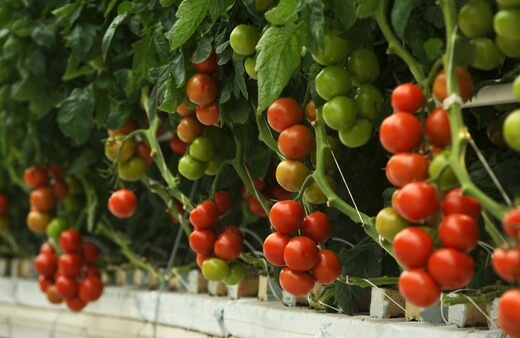
As well as our beginner's guide to hydroponics, we’ve put together a list of the best hydroponic plants you can grow at home. Check it out for more details on exactly what to grow, and how.
Different Types of Hydroponic Kits
There are three types of hydroponics for home growers, but all have some basic things in common; they all need clean water, nutrient supplements, and mesh pots. The three types of hydroponics suited to beginners are:
- Deep water hydroponics
- Running water hydroponics
- Mini hydroponic kits
Deep Water Hydroponics
Deep water hydroponics can be made at home, using some fairly simple materials. However, online kits are available with all the additional kits, pots, and air pumps you’ll need to get started, which can make the process much simpler.
Deep water hydroponics uses large bins or boxes as reservoirs, with closed lids. The lids prevent foreign contaminants, and small holes drilled through the top will support as many mesh pots as you can fit.
To maintain water oxygen levels, you’ll need an air pump that supplies and filters clean oxygen into the tank constantly. If you don’t have a reservoir with a lid, you can use styrofoam to create a floating raft for the mesh pots.
Pros
- Easy to set up
- Budget-friendly
- Low water usage
- Suitable for a range of edibles
Cons
- Constant running costs from air pumps
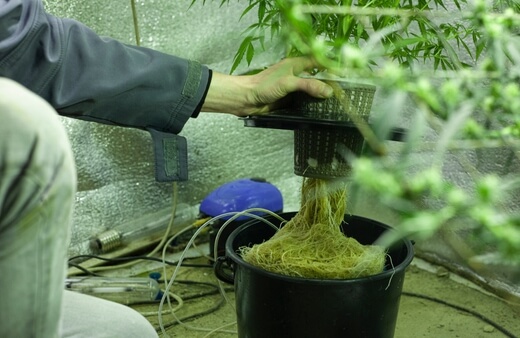
Running Water Hydroponics
Running water hydroponics might sound like they use amounts of water, but they can be set up with a pipe or tubing system, so the water is changed once every couple of days. Professional hydroponics use constantly flowing water, which circulates through filters to save water, but this has high running costs attached.
Tube systems are a useful in-between for beginners, providing the ability to change water easily, which adds oxygen and micronutrients. However, you will still have to add nutrients into the system once a week as a minimum to promote healthy growth.
Pros
- Less electricity for basic systems
- Cheap to buy
- Easy to use
- Usually come supplied with full kits, and any appropriate filters and pots
Cons
- Higher water usage
- It needs regular nutrients, which are depleted when water is changed
Mini Hydroponic Kits
Mini hydroponic kits are probably the best way to get started with hydroponics until you get used to managing plants solely in water. The kits can be picked up fairly inexpensively online, and are all self-contained.
The best mini hydroponic garden kits have UV lights, temperature sensors, and even nutrient and water level indicators that can connect to your smartphone.
Because of their small reservoirs, they need watering like most plants, as the water will be depleted as and when the plants drink it, meaning there is less wastewater, and the running costs are limited to the UV lamps’ electricity.
Pros
- Space saving
- Incredibly simple to use
- UV lamps are usually integrated
Cons
- Very varied price range
- Limited growing space
How to Set Up a Hydroponic System
Deep water hydroponics is the best way for beginners to get to know hydroponics, without restricting the number of plants you can grow, or ending up with huge water bills, and they’re really easy to get started.
Because they are based on a single body of water, and perpetually oxygenated, there is no need to recirculate or change the water throughout the lifespan of a plant. That means less root disturbance, less mess, and cheaper utility bills.

Before we run through the guide, make sure you’ve got everything you need using the kit guide below.
Equipment for Indoor Hydroponics
Air pumps
Arguably the most important part of indoor deep-water hydroponics is the air pump. Air pumps use minimal electricity to run, but produce a regular supply of oxygen, and, thankfully, you cannot over-oxygenate water, as the excess simply evaporates.
You’ll need an air pump complete with an air stone, not simply a constant low-pressure oxygen filter. Air stones, or airstones, slow the flow of oxygen and produce microscopic oxygen bubbles, which are easily held in the water.
The process also helps to circulate water as the pressure of rising oxygen from the bottom of the tank lifts sediment, with the added benefit of re-circulating any settled nutrients.
You can buy air stones from aquatics centres and pet shops, as they are a standard part of larger fish tank setups, but I tend to use these cylinder air stones, which lasts for around six weeks in constant use.
Mesh pots
Mesh pots aren’t essential for hydroponics, but they make everything a whole lot easier. By filling them with an inert substrate like coir, you can sow directly into them. Once seeds have germinated in the moist coir they can be planted in the water tank, pots included.
Depending on the crop, use a different size mesh pot, or planting basket. For salads, I usually use small mesh pots, and for herbs, which tend to grow bigger and with a longer season, I’ll use large mesh pots. This is simply to give roots more space without competition, but the reality is that after a few weeks, the roots will be largely reliant on the water and escape their baskets.
To get started, check out these mesh pot kits which come with the perfect substrate for sowing and planting.
Grow lights
Another non-essential bit of kit, but one that will come in handy for indoor growers and growers who need to control day lengths and light exposure is UV lamps. LED grow lights are perfect for hydroponics but do cost a lot to run even if they are cheaper these days than the old halogen systems.
Check out our guide to the best LED Grow Lights in Australia before buying any though, as we’ve got full details on what to look for, and how to calibrate your grow lamps.
Basic hydroponics kit
As well as some of the more dedicated kits for deep water hydroponics, you’ll need the following to keep track of pH levels, nutrients, and water conditions:
- pH meter
- pH reducer
- Liquid nutrients
Use your pH meter (or a pH test kit) once a week, as plant roots can acidify and reduce acidity, while airstones from different manufacturers can affect water health. To reduce pH, we use a pH reducer called pH Down which works quickly without damaging plants.
Liquid nutrients are essential for hydroponics, as all other plants get their nutrients from the soil, and from compost or plant food. Tap water, or rainwater, when standing in a container or reservoir will require hard water liquid nutrients in just the right amounts.
We use a hydroponic-based nutrient fertiliser system which comes with three uniquely adapted fertilisers for each growth stage, and feed our 50-litre tank once every 1-2 weeks, depending on the crop.
Reservoir
And last but not least is the only 100% essential piece of kit: the reservoir. Now, I could sit here and type up reasons to buy this that, or the other type of container, but in reality, any container that blocks light from the roots, and holds several litres of water will suffice.
Our first DIY deep water hydroponics setup used a basic plastic storage box with holes drilled out of the lid. Today, we use more purpose-built reservoirs, but they don’t have any impact on growing conditions.
Just be sure that it isn’t transparent or translucent and UV light getting to the roots can harm their growth, as well as promote the development of algae.
Indoor Deep Water Hydroponics Step-by-Step Guide

To make a DIY deep water hydroponics system, start by preparing your reservoir:
- In a tight-fitting lid or styrofoam raft, drill holes that support the rim of your mesh pots exactly. They should not be able to move without a little bit of effort.
- To drill the holes, place plastic lids firmly between two pieces of timber, and clamp them in place. Using an appropriate drill bit, drill straight through both pieces of wood. This should produce neat holes without cracking the plastic.
- If your holes are too large for a standard drill bit, use a hole saw to cut the exact hole size you need.
- Drill holes in the grid, about 5cm apart, and, where possible, retain the cut-out discs (you might need them for later).
- That’s the reservoir ready to use!
Now, it’s time to set up the air pump:
- Your air pump needs to be OUT OF THE TANK at all times. The pump is an electric unit, and very, very rarely watertight.
- Assemble the pump with enough tubing to drape into the tank.
- Insert the tubing into the end of the airstone & check the valves are clear and connections are completely secure.
- Place the airstone in the tank.
Time to fill the tank!
- Place the tank in its final position before adding any water (a 50-gallon tank is heavy, and you’ll end up with water going everywhere if you try to carry it).
- Fill the tank to about 1” below the rim. Enough to allow for roots and pots to drop in without it spilling.
- Following the instructions on the bottle, add nutrients to the water (both A and B nutrients). Most require less than a teaspoon of each nutrient per litre, so measure this out carefully.
- Wait for five minutes while the nutrients settle in the tank, and then check the pH using your pH meter. Lower the pH if necessary to achieve a pH that is very slightly acidic (this helps roots take up nutrients).
And finally…
- Plug in and turn on the air pump.
- Place the lid onto the tank.
- Insert your plants.
- Turn on any LED grow lights or additional ventilation if you are using them.
- Done.
NOTE: Remember those plastic discs we kept earlier? They can come in really handy now. To keep your hydroponic kit clean, tape them over any unused planting holes to stop dust and debris from settling into the water.
You can create hinged flaps with duct tape, or fasten them completely. We advised spacing your holes 5cm apart, which is ideal for herbs and microgreens, but for bigger veggies, you need to plant up to 30cm apart, depending on their eventual size.
Setting Up a Hydroponic Greenhouse
Setting up a hydroponic system is quite easy. It could be set up both indoors and outside the house. When you set it up in outdoor settings, then building it as a hydroponic greenhouse is the ideal option.
The reason for this is that any outdoor hydroponic system had to be sheltered and covered from rain. Otherwise, the rainwater could easily dilute the solution providing the nutrients to the plants and the pH of the solution would also change quickly and significantly.
Additionally, when you set up a hydroponic greenhouse, humidity and warmth are kept at optimum levels and the greenhouse is also protected from stray animals. The completely controlled environment of hydroponic greenhouse is the most perfect one that you could ever have in your house for growing plants.
Hydroponic Greenhouse Site Selection and Layout
The first point to consider while planning a hydroponic greenhouse is the site selection and preparation. The site chosen for the greenhouse should be easy to access, have enough proximity to an electrical outlet, and should receive a minimum of 4 to 6 hours of sunlight every day.
Normally, the ideal greenhouse construction area is about 18ft by 14ft but this could be adjusted to the available area. At the outset, you need to mark the 4 corners to erect the greenhouse structure. Even if the selected area is 18ft by 14ft, it is better to build the structure as a square one, instead of a rectangular one.
This is due to the reason that the square structure usually withstands a lot more stress than a rectangular structure and the construction process would also be easier.
Gathering the Materials
After completing the layout of the structure, you should assemble the necessary materials and tools to construct the greenhouse structure. You would require PVC sheets, plastic sheets, plastic zip ties, pine boards, some amount of deer netting, a few screws, and hinges to construct the hydroponic greenhouse. You need not possess a huge amount of mechanical engineering knowledge for this.
Construction Process
Several websites offer the process of construction of the hydroponic greenhouse. The floor should be prepared properly so that it withstands spills. The electricity is needed to add light inside the greenhouse when the sunlight is absent. You could use special grow-lights of full spectrum type.
Running Your Hydroponic Greenhouse
When the hydroponic greenhouse chamber is ready, you should purchase a drum with a capacity of 100-150 litres to hold the nutrient solution. You would also require hydroponic growing chambers like tubs and/or pots, growing media such as water gel, pearlite, etc, ventilation fans if the plants grown inside the hydroponic greenhouse structure are larger in number, and hydroponic fertilisers.
If you are just starting on hydroponic greenhouse farming, then you would be better off to start with young plants or starts instead of seeds of the plants that you wish to grow.
Importance of Digital pH Tester and CF Meter
You should not forget to purchase two items that are a must in the success of hydroponic greenhouse farming. They are the digital pH tester and CF meter. They would be needed to check the pH of the nutrient solution and the nutrient strength respectively. If you try to guess these values, you would only be harming the plants.
The hydroponic solution of water and fertilisers or the water gel crystals should have an average nutrient strength of 20 to 24 CF and a pH in the range of 5.5 to 6.5. The plants selected by you should not be the type that get pollinated by wind or insects, since both are absent in a hydroponic greenhouse.
Ideal Hydroponic Greenhouse Plants
The ideal greenhouse plants are cauliflower, broccoli, kale, silver beet, and leeks. Several herbal plants grow very well in hydroponic greenhouse constructions.
For example, lettuce is a cool weather crop. The seeds germinate only when the temperature inside the greenhouse is maintained below 27°C, preferably in the range of 16 to 24°C. Red light with full spectrum fluorescent lamps helps the lettuce germinate more effectively.
If you are growing broccoli, barley, beets, rye, cauliflower, cabbage and mustard seed member crops such as mustard, candytuft, wallflower, cress, and sweet alyssum in the greenhouse, they would seriously affect the growth of lettuce. Hence, all these plants should be kept separate from the area where lettuce is grown.
When you understand the above basics of hydroponic greenhouse, you would even be able to grow many of these plants in your greenhouse and earn handsome money by selling them in the market.
Hydroponics Frequently Asked Questions
Can you sow directly into hydroponics?
If you don’t have a propagation station, windowsill, cold frame, or greenhouse available to grow seedlings, or simply want to keep things simple, it’s perfectly ok to start your seeds in hydroponics.
Choose seeds that don’t suffer from moisture problems here though, because some plants like tomatoes and basil are very likely to suffer as small seedlings from excess moisture, even in controlled environments.
Try basil, or larger seeded hydroponics like hemp, which benefits from soaking before germination.
Can you grow cuttings using hydroponics?
Hydroponics is a perfect way to take softwood, greenwood, or basal cuttings from any plants. Even hemp cuttings can be taken mid-season and added to an existing hydroponic setup, and will flower at exactly the same time as their parents - great for topping plants and encouraging new, but shorter productive crops over the same period.
What is the best pH for hydroponics?
Hydroponics should be kept between 5.5 and 7pH. That is the ‘slightly acidic’ range where the majority of plants will perform at their best. This is thanks to the effects of acid on roots, which aids in the breakdown of nutrients.
Why do nutrients matter in hydroponics?
Like any growing condition, nutrients matter in hydroponics. When you take soil out of the growing equation, you are asking plants to grow in a completely neutral environment.
For some plants, tap water’s default additives can be beneficial - like calcium for tomatoes, but they still need additional nitrogen, and won’t fruit properly without added phosphorus and potassium.
Can you use clear containers for hydroponics?
Never use clear containers for hydroponics. Clear, or even translucent containers create a bright, warm space, where algae can thrive. Not only that, roots that are exposed to sunlight can self-prune.
Self-pruning isn’t the worst-case scenario for roots, but it will restrict their growth.
Can you use hydroponics outdoors?
Hydroponics, particularly deep water hydroponics is a great way to save space outdoors, but you will need to include an outdoor, rainproof, air pump, or introduce oxygenating plants to your system, which are less effective, but safer for outer conditions.
What is the easiest thing to grow hydroponically?
Basil is by far the easiest plant to grow hydroponically. Even in standing, unoxygenated water, basil can thrive, producing gorgeous, leafy displays. However, you will still need to add nutrients if you want good flavour.
Wrapping Up Our Hydroponics Guide for Beginners
Hydroponics is presented as a challenge for any new gardener, but it doesn’t have to be. Using these simple techniques, and affordable DIY hacks, you can grow hydroponically at home, with nothing but a few simple tools you can buy online or from your local aquatics centre.
There are more advanced ways to use hydroponics and to grow vertically, but for a simple beginner’s setup, deep water hydroponics has to be the way forward and is sure to bring more and more gardeners into this space-saving, water-saving way of growing food for the modern age.
Published on November 1, 2022 by Gary Clarke
Last Updated on September 9, 2025


